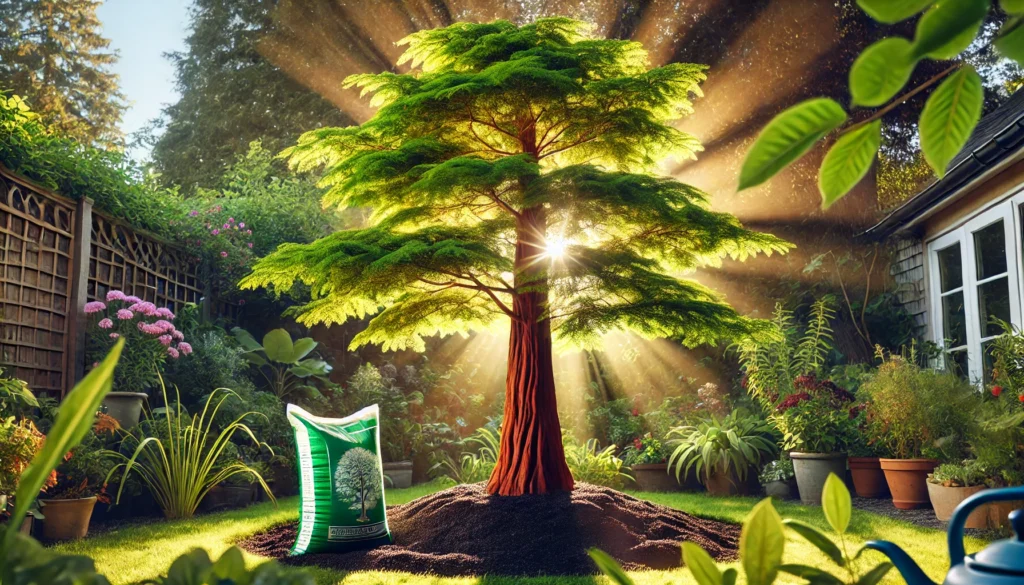
How to Choose the Best Redwood Tree Fertilizer for Healthy Growth
When it comes to nurturing a redwood tree, choosing the right fertilizer can make all the difference. 
In this guide, we’ll help you navigate the world of redwood tree fertilizer, showing you how to select the best type, when to apply it, and the right techniques to ensure your tree thrives. If you want your redwood to grow strong, healthy, and beautiful, this article is packed with expert tips you won’t want to miss. Let’s dive in and give your redwood the boost it needs!
Table of Contents
ToggleUnderstanding Redwood Tree Nutritional Needs 
Redwood trees are magnificent giants that require specific nutrients to thrive, ensuring they grow strong and healthy. If you’re planning to plant or maintain a redwood tree, understanding its nutritional needs is essential for optimal growth. Let’s break down what these trees need to stay vibrant and reach their full potential.
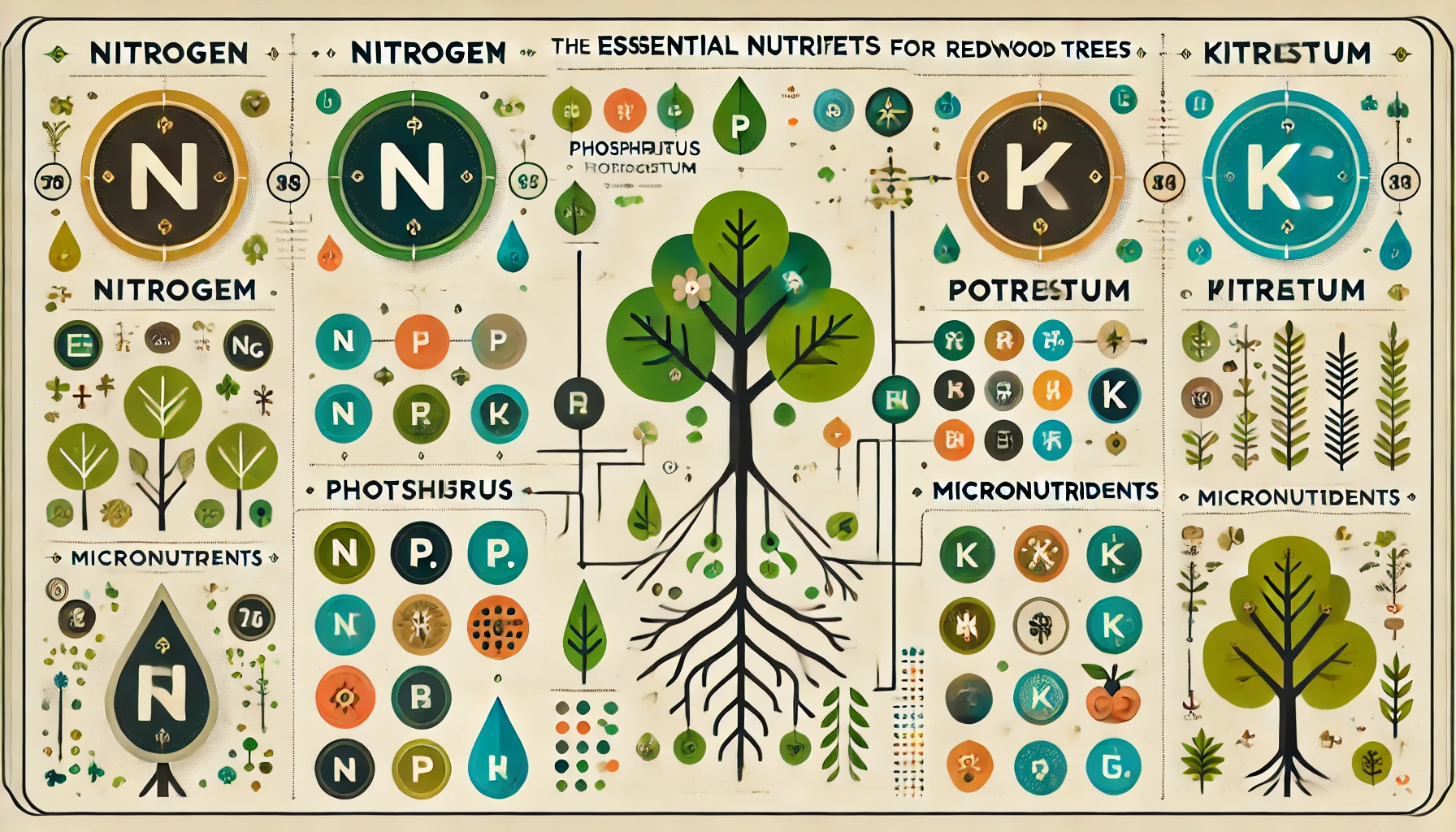
Essential Nutrients for Redwood Trees 
- Nitrogen (N) – The Growth Booster
Nitrogen is crucial for redwood trees as it promotes healthy leaf and stem growth. It helps the tree build strong foliage, which is necessary for photosynthesis. If your tree’s leaves are yellowing, it might be a sign of nitrogen deficiency. Look for fertilizers high in nitrogen to give your tree that much-needed boost. - Phosphorus (P) – Root and Flower Health
Phosphorus supports root development, which is vital for stabilizing your redwood tree and helping it absorb water and nutrients from the soil. It also plays a role in flowering, although redwoods are not known for their flowers, phosphorus helps maintain overall plant health. A balanced fertilizer with moderate phosphorus is ideal. - Potassium (K) – Stress Resistance
Potassium helps redwood trees endure stressful conditions like drought, disease, or pest attacks. It aids in cell function and strengthens the tree’s immune system. Potassium is essential for the long-term health and survival of your redwood. - Micronutrients – The Little Helpers
While not needed in large amounts, micronutrients like magnesium, calcium, sulfur, iron, and manganese play important roles in redwood tree health. Magnesium, for example, helps with chlorophyll production, and calcium is crucial for cell wall structure. Ensure your fertilizer includes these micronutrients for a well-rounded feeding plan.
Soil pH and Redwood Trees 
Redwoods prefer slightly acidic soil, with a pH range between 5.5 and 7. If the soil is too alkaline or too acidic, the tree may not absorb nutrients effectively. Conduct a simple soil test to measure pH levels and amend the soil if necessary.
When to Fertilize Your Redwood 
Timing is everything! Apply fertilizer during the active growing season (spring through summer). Avoid fertilizing in late fall or winter when the tree is dormant. Over-fertilizing can cause stress or burn the roots. A slow-release fertilizer is ideal, as it provides a steady supply of nutrients over time.
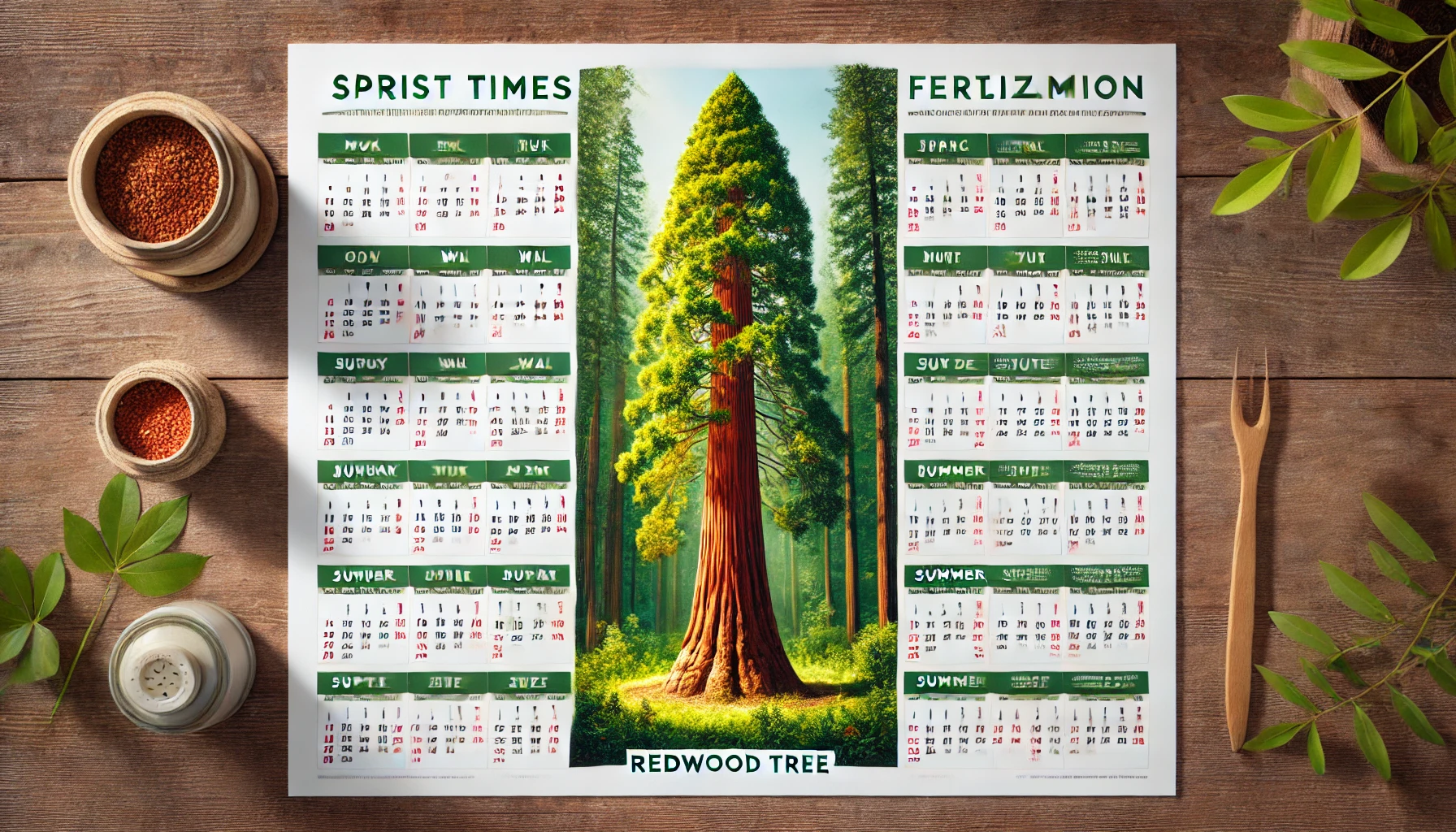
Signs of Nutrient Deficiencies 
Watch for signs that your redwood may not be getting the nutrition it needs:
- Yellowing leaves: Often a sign of nitrogen deficiency.
- Stunted growth: Could be due to a lack of phosphorus.
- Weak branches: May indicate potassium deficiency.
- Discoloration or spots on leaves: Micronutrient imbalances at play.
Conclusion 
By understanding and meeting your redwood tree’s nutritional needs, you’ll be setting it up for long-term health and growth. Whether you’re planting a new tree or nurturing an established one, choose a fertilizer that’s rich in nitrogen, phosphorus, and potassium, while also offering essential micronutrients. Happy planting!
Types of Redwood Tree Fertilizer 

Choosing the right fertilizer for your redwood tree is essential for its health and growth. But with so many options available, it can be a bit overwhelming! Let’s break it down into simple categories so you can find the perfect match for your tree.
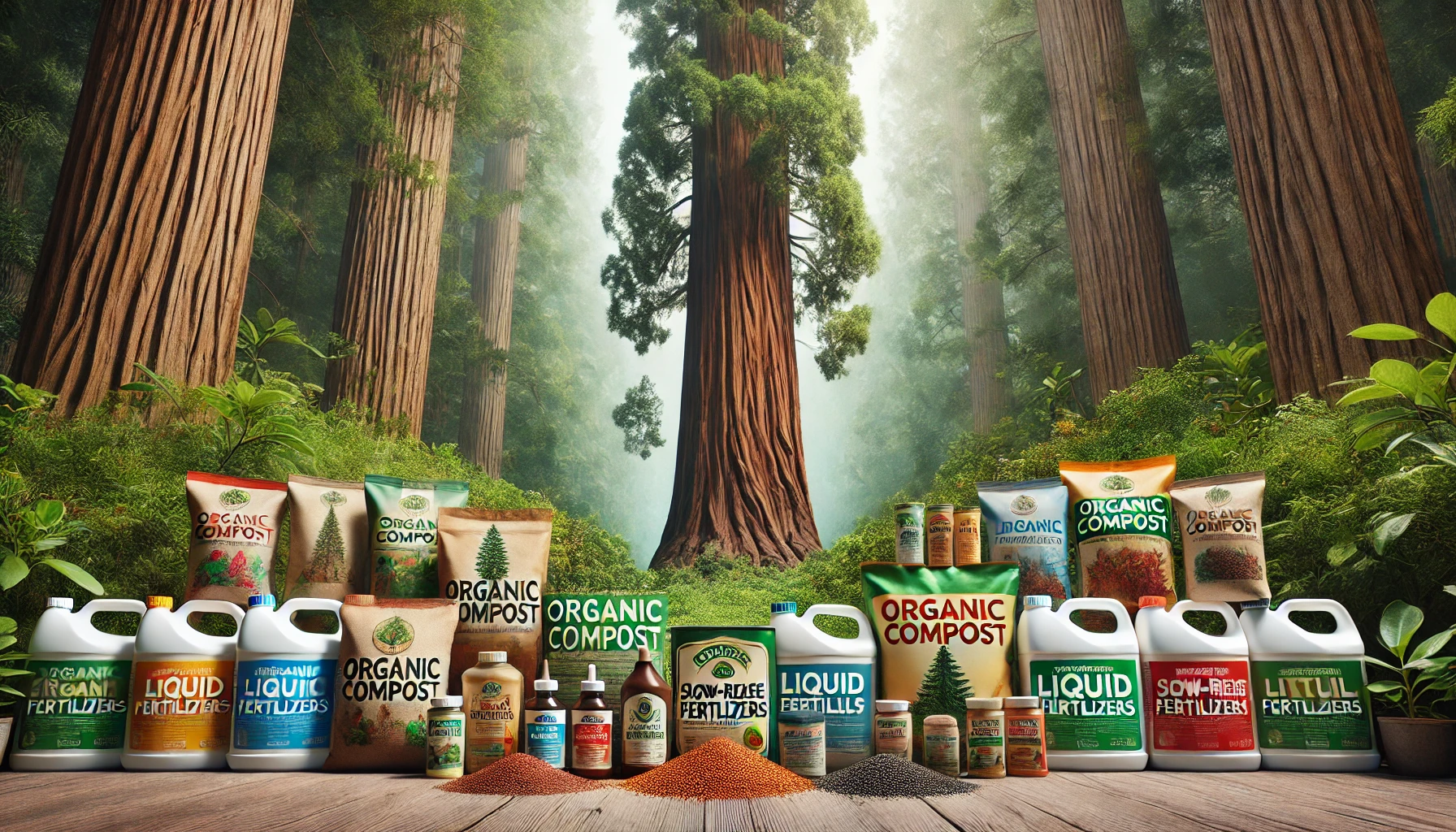
1. Organic Fertilizers 
Organic fertilizers are a fantastic choice for redwoods because they improve the soil quality and provide slow-release nutrients. These fertilizers are made from natural materials like compost, manure, or fish emulsion. They work gently to enrich the soil and encourage strong, sustainable growth.
- Benefits: Environmentally friendly, improves soil structure, long-lasting effects.
- Examples: Compost, well-aged manure, fish meal, seaweed extract.
Tip: Organic options are great for beginners or anyone looking to boost soil health without relying on synthetic chemicals.
2. Synthetic (Chemical) Fertilizers 
Synthetic fertilizers are fast-acting and often provide an immediate nutrient boost to your redwood tree. They typically contain a mix of nitrogen (N), phosphorus (P), and potassium (K)—the essential nutrients that trees need to thrive.
- Benefits: Quick results, precise nutrient control, can be cheaper.
- Examples: Balanced 10-10-10, high-nitrogen blends, or specific tree formulas.
Tip: These fertilizers work best if you’re looking for a quick fix or need to correct a nutrient deficiency in your redwood. Just be careful not to overdo it, as too much fertilizer can harm the tree.
3. Slow-Release Fertilizers 
Slow-release fertilizers are a great middle ground between organic and synthetic options. These fertilizers release nutrients gradually over time, ensuring that your redwood tree gets a steady supply of nourishment without the risk of nutrient burn.
- Benefits: Consistent nutrient release, less risk of over-fertilizing, low maintenance.
- Examples: Osmocote, slow-release pellets, or organic-based slow-release formulas.
Tip: If you’re a busy gardener or want to set it and forget it, slow-release fertilizers are a top choice!
4. Liquid Fertilizers 
Liquid fertilizers are applied directly to the soil or foliage and are quickly absorbed by the tree. They’re great for providing immediate nutrients and can be especially useful for addressing specific deficiencies.
- Benefits: Fast absorption, customizable nutrient application.
- Examples: Liquid seaweed, liquid fish emulsion, or balanced liquid fertilizers.
Tip: Use liquid fertilizers during the growing season, especially if you notice yellowing leaves or stunted growth.
5. Mulch and Compost 
While not technically a fertilizer, using mulch and compost around the base of your redwood tree can provide natural, slow-releasing nutrients over time. These materials also help retain moisture and improve soil quality, making them a great addition to any fertilizing plan.
- Benefits: Improves soil health, conserves moisture, and reduces weeds.
- Examples: Wood chips, leaf mulch, or homemade compost.
Tip: Apply a 2-3 inch layer of mulch around your redwood to help keep the soil healthy and your tree thriving.
Choosing the Right Fertilizer for Your Redwood 
When selecting a fertilizer for your redwood, consider factors like the age of the tree, the time of year, and your overall soil health. Whether you opt for organic, synthetic, or slow-release options, the key is to find a balance that suits your tree’s needs. By giving your redwood the right nutrition, you’ll set it up for long-term success and beautiful growth!
How to Choose the Right Redwood Tree Fertilizer 
Choosing the right fertilizer for your redwood tree is key to ensuring healthy growth, vibrant foliage, and strong roots. While redwoods are relatively low-maintenance, providing them with the proper nutrients can make a huge difference in their overall health and vitality. Here’s how to choose the best fertilizer to keep your redwood tree thriving:
1. Understand Your Tree’s Nutritional Needs 
Redwood trees require a balanced mix of essential nutrients, including nitrogen (N), phosphorus (P), and potassium (K). These macronutrients help the tree grow, develop strong roots, and withstand environmental stress. While redwoods are known to adapt well to various soil conditions, ensuring they get the right nutrient balance is crucial for their long-term health.
2. Consider Organic vs. Synthetic Fertilizers 
You have two main types of fertilizer options: organic and synthetic. Organic fertilizers, like compost or slow-release pellets, are a natural choice and enrich the soil over time. They also improve soil structure and promote beneficial microbial activity. Synthetic fertilizers, on the other hand, provide immediate nutrient boosts and are often more concentrated, but they don’t improve soil quality in the long run. Both have their pros and cons, so consider what fits your needs and environmental values.
- Organic Fertilizer: Slow release, eco-friendly
- Synthetic Fertilizer: Quick results, high concentration
3. Focus on Slow-Release Fertilizers 
When it comes to redwood trees, slow-release fertilizers are often the best option. These fertilizers gradually release nutrients into the soil over time, providing a consistent supply of nutrients to the tree. This is ideal for redwoods, as it avoids nutrient overload while ensuring steady growth without the risk of burning the roots.
4. Pay Attention to the NPK Ratio 
The NPK ratio on fertilizer bags tells you the proportion of nitrogen, phosphorus, and potassium in the mix. For redwood trees, look for a balanced ratio like 10-10-10 or 15-15-15. This means equal parts of each nutrient, providing comprehensive support for both growth and root development. If your soil is lacking specific nutrients, you may want to adjust the ratio accordingly.
- Nitrogen (N): Promotes healthy foliage and overall growth
- Phosphorus (P): Strengthens roots and helps with flowering
- Potassium (K): Enhances disease resistance and stress tolerance
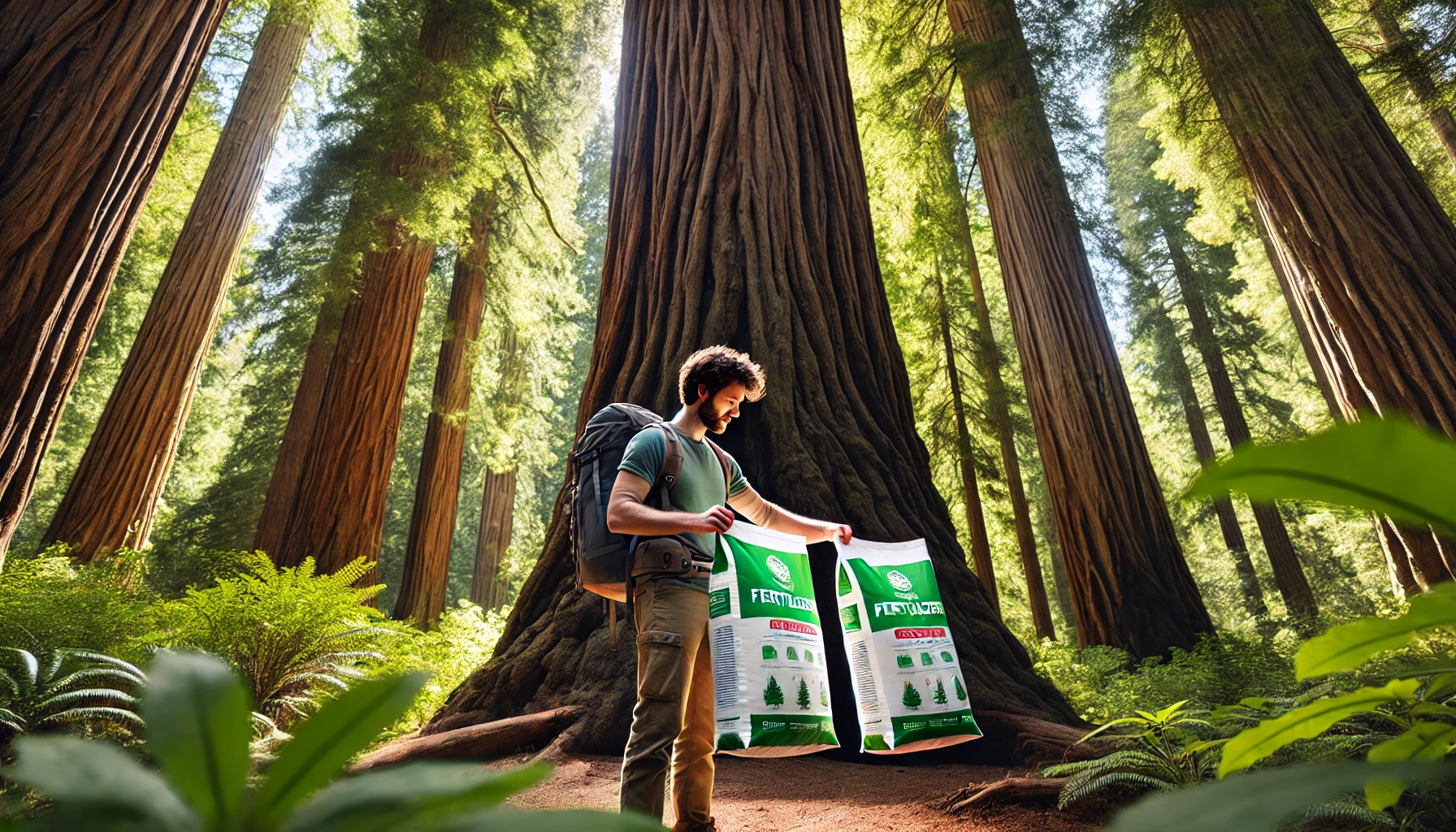
5. Check Your Soil’s Nutrient Levels 
Before you start fertilizing, test your soil to determine what nutrients are already present. Soil tests are inexpensive and easy to perform. This way, you can avoid over-fertilizing and wasting money on nutrients your tree doesn’t need. You may find that your soil is rich in some nutrients but lacking in others, guiding you to choose a fertilizer that fills in the gaps.
6. Fertilize at the Right Time of Year 
Timing matters when it comes to fertilizing your redwood tree. The best time to fertilize is in early spring when the tree is waking up from dormancy. Avoid fertilizing in late fall, as this can stimulate new growth that may not survive the winter. Follow the manufacturer’s instructions for application rates to prevent over-fertilizing, which can harm the tree.
7. Use Fertilizer Sparingly 
Less is often more when it comes to fertilizing redwood trees. Over-fertilizing can damage the roots and harm the environment. It’s important to use only the recommended amount to avoid nutrient imbalances. Remember, slow and steady growth is ideal for these majestic trees!
Final Thoughts 
Choosing the right fertilizer for your redwood tree isn’t difficult, but it does require some thought and care. By understanding your tree’s needs, selecting the appropriate type of fertilizer, and applying it at the right time, you can enjoy a flourishing, healthy redwood tree that grows strong and beautiful year after year!
How to Apply Redwood Tree Fertilizer 
Fertilizing your redwood trees is a simple but essential task to ensure their health and growth. Here’s a step-by-step guide on how to apply fertilizer properly to get the best results.
1. Choose the Right Fertilizer for Your Redwood 
Before applying any fertilizer, it’s important to choose the right one. Look for a balanced fertilizer, like a 10-10-10 or 20-10-10, that provides equal or slightly higher amounts of nitrogen (N), phosphorus (P), and potassium (K). These nutrients support root growth, overall health, and resistance to stress. Organic options, such as compost or fish meal, are excellent for a more natural approach.
2. Determine the Right Timing 
The best time to fertilize your redwood trees is during the spring, when new growth begins. Fertilizing during this period provides the tree with essential nutrients to fuel its growth for the rest of the year. Avoid fertilizing in winter when the tree is dormant, as it won’t absorb the nutrients properly.
3. Calculate the Correct Amount 
Over-fertilizing can harm your redwood tree, so it’s crucial to apply the right amount. Generally, for a young tree, use about 1 pound of fertilizer per inch of trunk diameter. For mature trees, the amount varies depending on the size and age. Always check the instructions on the fertilizer packaging for specific guidelines.
4. Apply the Fertilizer Around the Root Zone 
Fertilizer should be applied evenly around the root zone of your redwood, which extends beyond the base of the tree. For best results, sprinkle the fertilizer in a circular pattern around the tree, starting about 12 inches from the trunk and working outward to the drip line (where the branches end). This ensures the roots can easily absorb the nutrients.
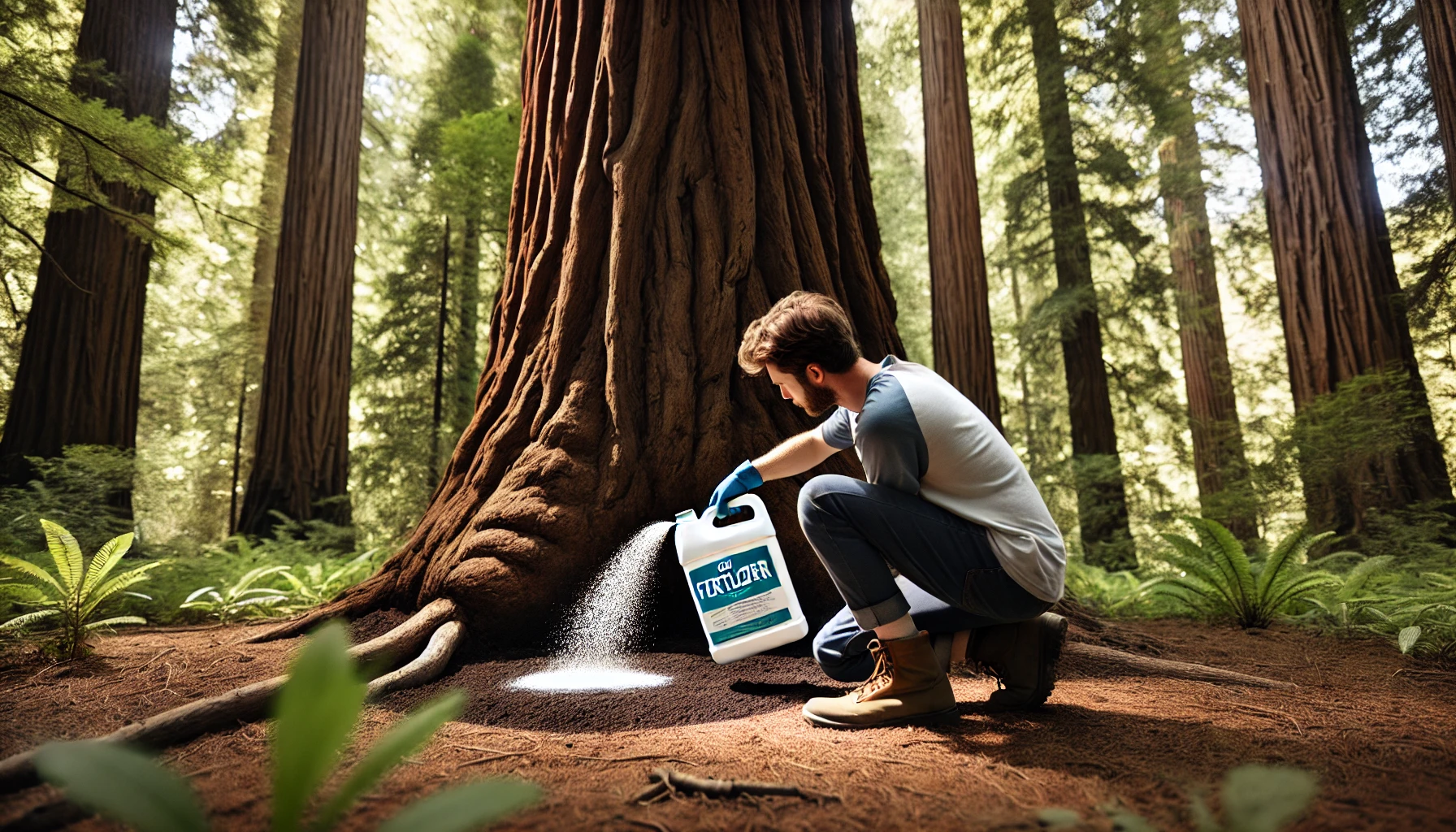
5. Water After Fertilizing 
Once the fertilizer is applied, water the area thoroughly. Watering helps the nutrients dissolve into the soil, allowing the roots to absorb them more effectively. Be sure to keep the soil moist, but avoid overwatering, as this can lead to root rot.
6. Mulch for Extra Protection 
After fertilizing, adding a layer of mulch around the base of your redwood tree can help retain moisture and provide additional nutrients as it decomposes. Be sure to leave a small gap around the trunk to prevent mold or pests from settling in.
7. Monitor Your Tree’s Growth 
Keep an eye on your redwood’s growth after fertilizing. Healthy trees will show vibrant green foliage and strong growth. If the tree doesn’t seem to be thriving, check for issues like poor soil drainage or pests, as these can affect nutrient uptake.
By following these simple steps, your redwood tree will have the nutrients it needs to grow strong and thrive. Regular fertilization can ensure your tree remains healthy for years to come!
Common Mistakes to Avoid When Choosing Redwood Tree Fertilizer 
When it comes to choosing the right fertilizer for your redwood trees, even small mistakes can lead to poor growth or long-term damage. Here are some of the most common pitfalls to avoid for the healthiest, happiest trees:
1. Over-Fertilizing 
Many gardeners make the mistake of using too much fertilizer, thinking it will boost growth. However, over-fertilizing can burn the roots, harm the soil, and cause nutrient imbalances. Always follow the recommended dosage on the fertilizer label and remember that less is often more!

2. Choosing the Wrong Type of Fertilizer 
Not all fertilizers are created equal. Redwood trees thrive best with fertilizers that are specifically balanced for their needs—rich in nitrogen, phosphorus, and potassium. Avoid generic lawn fertilizers that may not provide the right mix. Look for fertilizers that support deep root growth and overall tree health.
3. Ignoring the Soil Quality 
The quality of your soil plays a big role in how well your fertilizer will work. If your soil is too acidic or too alkaline, it may not absorb nutrients effectively. Before applying any fertilizer, check your soil’s pH and amend it if needed. Your redwood will thank you for it!
4. Fertilizing at the Wrong Time 
Timing is key! Applying fertilizer during the wrong season or when your tree is dormant can lead to wasted nutrients and even stress your redwood. The best time to fertilize is during the early spring or late fall when the tree is actively growing.
5. Using Chemical Fertilizers Too Often 
Chemical fertilizers can provide quick results, but over time, they can harm the environment and the health of your tree. Consider switching to organic or slow-release fertilizers that nourish the soil and support long-term tree health.
6. Neglecting Watering After Fertilizing 
Fertilizing without watering is like setting up a meal and forgetting to eat! After applying fertilizer, always follow up with a thorough watering. This helps the nutrients move into the soil and reach the roots where they’re needed most.
By avoiding these common mistakes, you’ll be on your way to giving your redwood trees the best care possible. Happy gardening!
Conclusion
Choosing the right redwood tree fertilizer is crucial for ensuring your tree grows strong and healthy for years to come. By understanding the specific nutritional needs of your redwood, selecting the right type of fertilizer, and applying it correctly, you can foster optimal growth and vitality. Whether you opt for organic or synthetic fertilizers, the key is consistency and following the right practices to avoid over-fertilizing or nutrient imbalances.

With the expert tips shared in this guide, you’re now equipped to provide your redwood tree with the care it deserves. So, take action today—choose the best fertilizer for your tree, follow the application tips, and enjoy watching your redwood thrive!
Feel free to share your experiences or ask any questions in the comments below. We’d love to hear how your redwood tree is growing and offer further advice if needed!
Frequently Asked Questions(FAQ)
What’s the best fertilizer for a redwood tree?
The best fertilizer for redwood trees is a balanced, slow-release fertilizer with an NPK ratio of 10-10-10 or 14-14-14. This provides essential nutrients like nitrogen, phosphorus, and potassium, which promote strong growth, healthy roots, and resistance to disease. Organic options, like compost, are also excellent for providing steady nutrition without harming the soil.
How often should I fertilize my redwood tree?
Fertilize your redwood tree 2-3 times a year: early spring, mid-summer, and late fall. In spring, use a balanced fertilizer to support new growth, and during fall, apply a slow-release option to help the tree prepare for winter. Always follow the manufacturer’s instructions to avoid over-fertilizing.
Can I use compost instead of store-bought fertilizers for redwoods?
Yes, compost is a great natural alternative to store-bought fertilizers. It’s rich in organic matter and micronutrients, providing slow, steady nutrition that helps improve soil health and structure. Apply a layer of compost around the base of the tree annually for long-term benefits.
Should I use organic or synthetic fertilizer for my redwood tree?
Both organic and synthetic fertilizers can work well for redwood trees, but organic options are better for long-term soil health. Organic fertilizers, like compost or fish emulsion, improve soil structure and promote sustainable growth. Synthetic fertilizers provide faster results but may lead to nutrient imbalances if overused.
How do I know if my redwood tree needs fertilizer?
Signs that your redwood tree may need fertilizer include yellowing leaves, poor growth, or a lack of new shoots. If your tree is growing slowly or has stunted development, a nutrient boost could help it thrive. Test your soil for nutrient deficiencies to determine what kind of fertilizer it needs.
What type of soil is best for redwood trees when fertilizing?
Redwood trees prefer well-draining, loamy soil. If your soil is too sandy, you may need to amend it with organic matter to improve its ability to retain moisture and nutrients. If it’s too heavy or clayey, consider adding compost or organic mulch to improve drainage and prevent waterlogging.
Is it necessary to fertilize redwood trees every year?
While redwood trees don’t need to be fertilized every year, it’s beneficial to apply a light dose of fertilizer every 1-2 years to replenish soil nutrients. Older, mature trees may need less frequent fertilization, while young trees can benefit from regular feeding to promote healthy growth.
Can I fertilize a newly planted redwood tree?
Yes, you can fertilize a newly planted redwood tree, but be cautious. Use a low-nitrogen fertilizer to encourage root development without stressing the tree. Avoid fertilizing too soon after planting; wait until the tree establishes a root system before applying any fertilizer. A gentle organic fertilizer is ideal for young redwoods.








